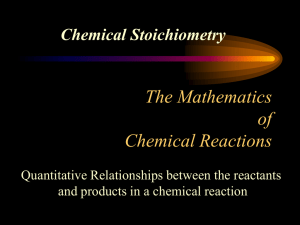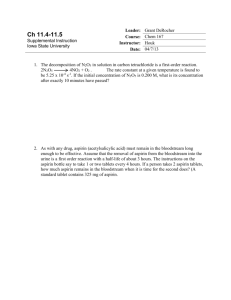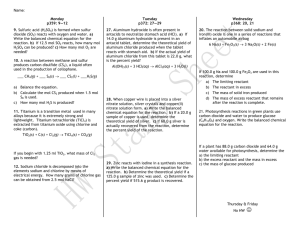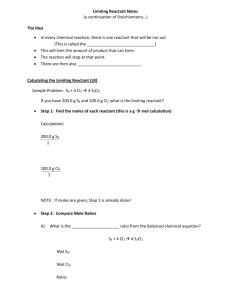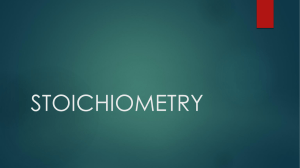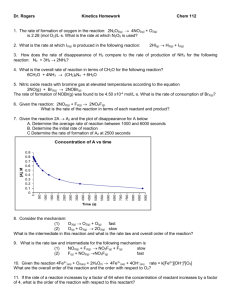Excess vs. Limiting Reactants Limiting Reactant – The reactant that
advertisement
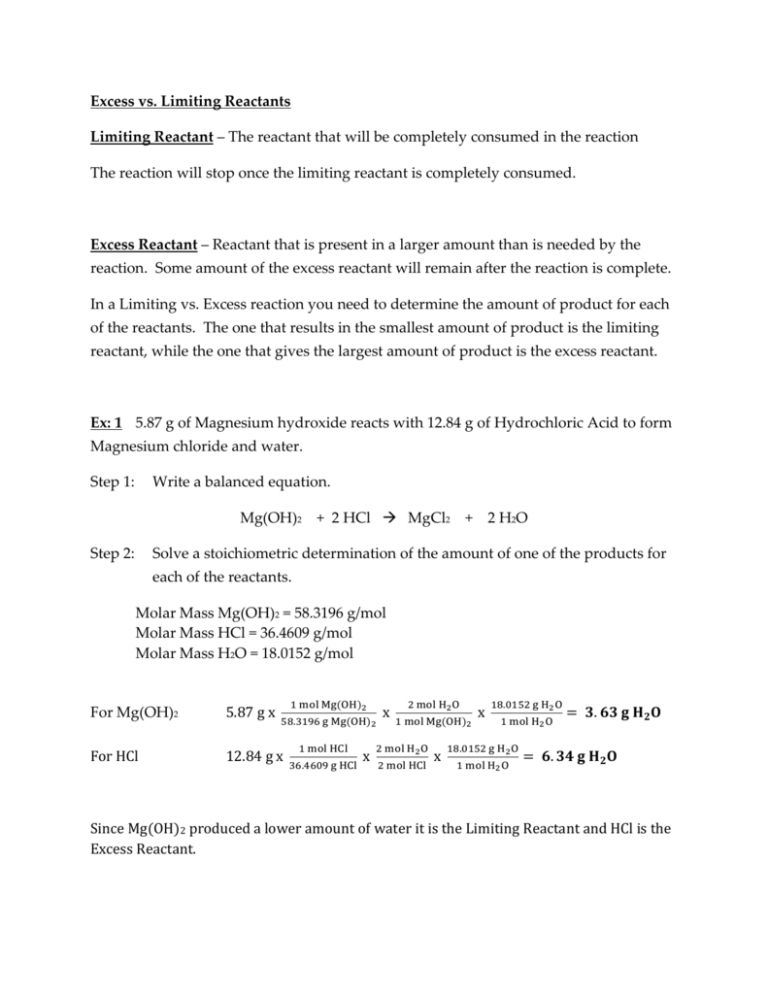
Excess vs. Limiting Reactants Limiting Reactant – The reactant that will be completely consumed in the reaction The reaction will stop once the limiting reactant is completely consumed. Excess Reactant – Reactant that is present in a larger amount than is needed by the reaction. Some amount of the excess reactant will remain after the reaction is complete. In a Limiting vs. Excess reaction you need to determine the amount of product for each of the reactants. The one that results in the smallest amount of product is the limiting reactant, while the one that gives the largest amount of product is the excess reactant. Ex: 1 5.87 g of Magnesium hydroxide reacts with 12.84 g of Hydrochloric Acid to form Magnesium chloride and water. Step 1: Write a balanced equation. Mg(OH)2 Step 2: + 2 HCl MgCl2 + 2 H2O Solve a stoichiometric determination of the amount of one of the products for each of the reactants. Molar Mass Mg(OH)2 = 58.3196 g/mol Molar Mass HCl = 36.4609 g/mol Molar Mass H2O = 18.0152 g/mol 1 mol Mg(OH)2 For Mg(OH)2 5.87 g x For HCl 12.84 g x 58.3196 g Mg(OH)2 1 mol HCl 36.4609 g HCl x x 2 mol H2 O 1 mol Mg(OH)2 2 mol H2 O 2 mol HCl x x 18.0152 g H2 O 1 mol H2 O 18.0152 g H2 O 1 mol H2 O = 𝟑. 𝟔𝟑 𝐠 𝐇𝟐 𝐎 = 𝟔. 𝟑𝟒 𝐠 𝐇𝟐 𝐎 Since Mg(OH)2 produced a lower amount of water it is the Limiting Reactant and HCl is the Excess Reactant. To determine the amount of Excess Reactant consumed by the reaction, calculate the amount of the excess reactant required to produce the amount of the product created by the limiting reactant. Amt of HCl consumed: 3.63 g H2 O x 1 mol H2 O 18.0152 g H2 O x 2 mol HCl x 2 mol H2 O 36.4609 g HCl 1 mol HCl = 𝟕. 𝟑𝟓 𝐠 𝐇𝐂𝐥 To find the amount of the excess reactant that is left after the reaction subtract the amount consumed from the original amount used. Amt of Excess Reactant = Amt Available – Amt consumed = 12.84 g – 7.35 g = 5.49 g HCl Ex: 2 1.05 g of Hydrogen are combined with 1.22 g of Oxygen to produce water. Determine the Limiting Reactant, Excess Reactant, Amount of Excess Reactant consumed and Amount of Excess Reactant remaining after the reaction. 2 H2 + O2 2 H2O Molar Mass H2 = 2.0158 g/mol Molar Mass O2 = 31.9988 g/mol Molar Mass H2O = 18.0152 g/mol For H2: 1.05 g H2 x For O2: 1.25 g O2 x 1 molH2 2.0158 g H2 1 molO2 31.9988 g O2 x x 2 mol H2 O x 2 mol H2 2 mol H2 O 1 mol O2 x 18.0152 g H2 O 1 mol H2 O = 9.38 g H2 O 18.0152 g H2 O 1 mol H2 O = 1.41 g H2 O Oxygen is the limiting reactant. Hydrogen is the excess reactant. 1 mol H2 O 1.41 g H2 O x Excess H2: 1.05 g – 0.158 g = 0.89 g H2 remain 18.0152 g H2 O x 2 mol H2 H2 consumed: 2 mol H2 O x 2.0158 g H2 1 molH2 = 0.158 g H2 Ex 3: 12.20 g of Iron rusts to form Iron (III) oxide. The amount of Oxygen available is 4.52 L. Determine the Limiting Reactant, Excess Reactant, Amount of Excess Reactant consumed and Amount of Excess Reactant remaining after the reaction. 4 Fe + Molar Masses: 3 O2 2 Fe2O3 Fe = 55.845 g/mol O2 = 31.9988 g/mol Fe2O3 = 159.6882 g/mol For Fe: 12.20 g Fe x For O2: 4.52 𝐿 𝑂2 𝑥 1 mol Fe 55.845 g Fe 1 𝑚𝑜𝑙 𝑂2 22.4 𝐿 𝑂2 𝑥 x 2 mol Fe2 O3 4 mol Fe 2 mol Fe2 O3 3 mol O2 x x 159.6882 g Fe2 O3 1 mol Fe2 O3 159.6882 g Fe2 O3 1 mol Fe2 O3 = 𝟏𝟕. 𝟒𝟒 𝐠 𝐅𝐞𝟐 𝐎𝟑 = 𝟐𝟏. 𝟓 𝐠 𝐅𝐞𝟐 𝐎𝟑 Iron is the limiting reactant: Oxygen is the excess reactant. 1 mol Fe2 O3 O2 consumed: 17.44 g Fe2 O3 x O2 remaining: 4.52 L – 3.670 L = 0.85 L O2 159.6882 g Fe2 O3 x 3 mol O2 2 mol Fe2 O3 x 22.4 L O2 1 mol O2 = 𝟑. 𝟔𝟕𝟎 𝐋 𝐎𝟐 Percent Yield: Chemical reactions do not always run to completion and so the amount produced is not always what we expected or predicted by the stoichiometry calculations. There can be a variety of factors that reduce the actual yield. To indicate how affective a chemical process is we calculate the percent yield of the product. % 𝑌𝑖𝑒𝑙𝑑 = Ex: 𝐴𝑐𝑡𝑢𝑎𝑙 𝑦𝑖𝑒𝑙𝑑 𝑥 100 𝐸𝑥𝑝𝑒𝑐𝑡𝑒𝑑 𝑦𝑖𝑒𝑙𝑑 A reaction is expected to produce 5.78 g of Zinc chloride. When completed the amount of Zinc chloride produced is 4.97 g. Find the Percent Yield. % yield = 4.97 g x 100 = 𝟖𝟔. 𝟎% 5.78 g Sample Problems: Limiting vs. Excess Reactants Ex: 1 5.87 g of Magnesium hydroxide reacts with 12.84 g of Hydrochloric Acid to form Magnesium chloride and water. Ex: 2 1.05 g of Hydrogen are combined with 1.22 g of Oxygen to produce water. Determine the Limiting Reactant, Excess Reactant, Amount of Excess Reactant consumed and Amount of Excess Reactant remaining after the reaction. Ex 3 12.20 g of Iron rusts to form Iron (III) oxide. The amount of Oxygen available is 4.52 L. Determine the Limiting Reactant, Excess Reactant, Amount of Excess Reactant consumed and Amount of Excess Reactant remaining after the reaction. Percent Yield: Ex: A reaction is expected to produce 5.78 g of Zinc chloride. When completed the amount of Zinc chloride produced is 4.97 g. Find the Percent Yield.
